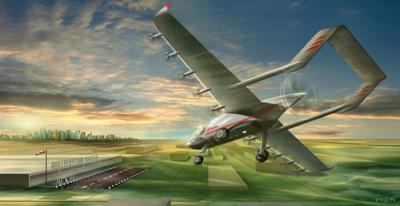Wed, Jun 10, 2020
The Single-Pilot eSTOL Carries 500 Pounds of Cargo -- Off 300 Foot Runways
Airflow is developing their first electric Short Take-Off and Landing (eSTOL) aircraft designed for middle-mile logistics. Airflow’s aerial logistics network can move short-haul cargo quickly and cost-effectively over traffic by utilizing the unused airspace around cities.

Five former Airbus Vahana team members, who have over 60 years of combined aerospace experience, started Airflow when they determined eSTOL aircraft could address the Urban Air Mobility (UAM) market for one-third the operating cost of electric Vertical Take-Off and Landing (eVTOL) aircraft. UAM is a transportation system using next-generation aircraft to move cargo and people in and out of urban areas by air.
The need for rapid middle-mile logistics capabilities (between 50 - 200 miles) is growing significantly due to e-commerce growth. To address that need, Airflow’s aerial logistics service can move cargo and time-sensitive medical supplies directly between warehouses without using traditional airports. Airflow’s eSTOL aircraft requires less than 150 feet to take off and land using a 300-foot runway, about the length of three helipads next to each other.
Airflow’s first eSTOL aircraft includes an electric propulsion system, single-pilot operations, and the ability to carry 500 lbs of cargo. This aircraft is a relatively simple fixed-wing aircraft, which dramatically reduces development and certification risk when compared with more complex aircraft. From a certification standpoint, eSTOL aircraft are conventional aircraft with new technology that is focused on enabling short-field capabilities. eSTOL aircraft can be certified under standard Part 23 regulations, whereas eVTOL aircraft must be certified using a more complicated and expensive process due to their more complex systems and potential failure modes.
“The demand for same-day e-commerce continues to rise, and we’re building a new low-cost aerial capability to enable that growth,” stated Marc Ausman, co-founder & CEO, “Our approach from the beginning is to focus on a simple aircraft design with well-defined new technology. In doing so, the team believes development and certification costs will be approximately $200MM versus more than $700MM for an eVTOL aircraft, making for more efficient use of capital.”
More News
With Testing Soon Complete, Launch Preparations Begin in Earnest Sierra Space's Dream Chaser has been put through the wringer at NASA's Glenn Armstrong Test Facility in Ohio, but w>[...]
Takeoff Roll The process whereby an aircraft is aligned with the runway centerline and the aircraft is moving with the intent to take off. For helicopters, this pertains to the act>[...]
“We’re proud of the hard work that went into receiving this validation, and it will be a welcome relief to our customers in the European Union. We couldn’t be mor>[...]
"Aircraft Spruce is pleased to announce the acquisition of the parts distribution operations of Wag-Aero. Wag-Aero was founded in the 1960’s by Dick and Bobbie Wagner in the >[...]
IDENT Feature The special feature in the Air Traffic Control Radar Beacon System (ATCRBS) equipment. It is used to immediately distinguish one displayed beacon target from other be>[...]
 Sierra Space Repositions Dream Chaser for First Mission
Sierra Space Repositions Dream Chaser for First Mission ANN's Daily Aero-Term (05.10.24): Takeoff Roll
ANN's Daily Aero-Term (05.10.24): Takeoff Roll Aero-News: Quote of the Day (05.10.24)
Aero-News: Quote of the Day (05.10.24) Aero-News: Quote of the Day (05.11.24)
Aero-News: Quote of the Day (05.11.24) ANN's Daily Aero-Term (05.11.24): IDENT Feature
ANN's Daily Aero-Term (05.11.24): IDENT Feature



